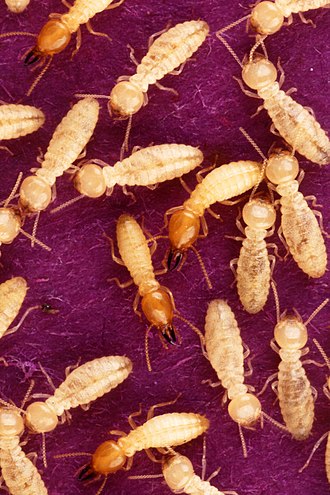Difference between revisions of "AY Honors/Insect/Isoptera/es"
From Pathfinder Wiki
< AY HonorsAY Honors/Insect/Isoptera/es
(Created page with "Libro de respuestas de especialidades JA/Insecto/Isoptera") |
(Created page with "Species id/es |common_name = Termita |latin_name = Isoptera |order = Isoptera |image = Coptotermes formosanus shiraki USGov k8204-7.jpg |description = Las termitas se alimenta...") |
||
| Line 3: | Line 3: | ||
{{ | {{ | ||
| − | Species id | + | Species id/es |
| − | |common_name = | + | |common_name = Termita |
|latin_name = Isoptera | |latin_name = Isoptera | ||
|order = Isoptera | |order = Isoptera | ||
|image = Coptotermes formosanus shiraki USGov k8204-7.jpg | |image = Coptotermes formosanus shiraki USGov k8204-7.jpg | ||
| − | |description = | + | |description = Las termitas se alimentan principalmente de material vegetal muerto, generalmente en forma de madera, hojarasca, tierra o estiércol animal, y aproximadamente el 10% de las 4.000 especies estimadas (aproximadamente 2.600 conocidas taxonómicamente) son económicamente significativas como plagas que pueden causar daños estructurales graves a edificios, cultivos o plantaciones forestales. Las termitas son detrivores importantes, particularmente en las regiones subtropicales y tropicales, y su reciclaje de madera y otras materias vegetales tiene una importancia ecológica considerable. |
As social insects, termites live in colonies that, at maturity, number from several hundred to several million individuals. They are a prime example of decentralised, self-organised systems using swarm intelligence and use this cooperation to exploit food sources and environments that could not be available to any single insect acting alone. A typical colony contains nymphs (semi-mature young), workers, soldiers, and reproductive individuals of both genders, sometimes containing several egg-laying queens. | As social insects, termites live in colonies that, at maturity, number from several hundred to several million individuals. They are a prime example of decentralised, self-organised systems using swarm intelligence and use this cooperation to exploit food sources and environments that could not be available to any single insect acting alone. A typical colony contains nymphs (semi-mature young), workers, soldiers, and reproductive individuals of both genders, sometimes containing several egg-laying queens. | ||
Revision as of 00:40, 17 January 2019
| Isoptera (Termita) | |
|---|---|
|
Orden: Isoptera
Descripción: Las termitas se alimentan principalmente de material vegetal muerto, generalmente en forma de madera, hojarasca, tierra o estiércol animal, y aproximadamente el 10% de las 4.000 especies estimadas (aproximadamente 2.600 conocidas taxonómicamente) son económicamente significativas como plagas que pueden causar daños estructurales graves a edificios, cultivos o plantaciones forestales. Las termitas son detrivores importantes, particularmente en las regiones subtropicales y tropicales, y su reciclaje de madera y otras materias vegetales tiene una importancia ecológica considerable.
As social insects, termites live in colonies that, at maturity, number from several hundred to several million individuals. They are a prime example of decentralised, self-organised systems using swarm intelligence and use this cooperation to exploit food sources and environments that could not be available to any single insect acting alone. A typical colony contains nymphs (semi-mature young), workers, soldiers, and reproductive individuals of both genders, sometimes containing several egg-laying queens.
|
Isoptera
|

